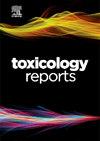ADME/Tox研究及β-石竹烯对携带QacA/B外排泵基因的金黄色葡萄球菌耐药菌株的影响
Q1 Environmental Science
引用次数: 0
摘要
革兰氏阳性细菌金黄色葡萄球菌是引起社区获得性感染和卫生保健相关感染的原因,由于外排泵的存在,它表现出高度的抗生素耐药性。这些泵,如QacA和QacB,是排出有毒物质的蛋白质,包括抗生素,使感染治疗更加困难。在对抗这种抗性的替代品中,有萜烯,如β-石竹烯,由于其非极性性质,有可能抑制这些外排泵。考虑到这一点,本研究的目的是研究上述萜烯在金黄色葡萄球菌中作为QacA/B泵抑制剂的能力,并分析其药代动力学和毒理学特性。首先,利用AutoDock VINA软件利用QacA蛋白的CryoEM结构进行分子对接模拟,以评估β-石竹烯与目标蛋白之间的相互作用。随后,进行体外实验,测定β-石竹烯在金黄色葡萄球菌耐药菌株中的最低抑制浓度(MIC)及其与氨苄西林联合抑制外排泵的能力。此外,使用SwissADME平台进行了计算机ADMET预测。结果表明,萜烯增强了氨苄西林的作用,使最小抑制浓度(MIC)降低了50% %。但不能降低溴化乙锭的MIC。硅分析表明,β-石竹烯具有良好的生物利用度和药物相似性,但在胃肠道吸收和脑通透性方面存在局限性。该研究得出结论,β-石竹烯是治疗抗生素耐药感染的一种有希望的佐剂,特别是由于它能够部分抑制外排泵。本文章由计算机程序翻译,如有差异,请以英文原文为准。
ADME/Tox study and the effect of β-Caryophyllene on the resistant strain of Staphylococcus aureus carrying the QacA/B efflux pump gene
The Gram-positive bacterium Staphylococcus aureus is responsible for causing both community-acquired and healthcare-associated infections, and it exhibits high antibiotic resistance due to the presence of efflux pumps. These pumps, such as QacA and QacB, are proteins that expel toxic substances, including antibiotics, making infection treatment more difficult. Among the alternatives to combat this resistance are terpenes, like β-caryophyllene, which have the potential to inhibit these efflux pumps due to their nonpolar nature. Considering this, the objective of this work is to investigate the ability of the mentioned terpene to act as an inhibitor of the QacA/B pump in S. aureus, as well as to analyze its pharmacokinetic and toxicological properties in silico. Initially, a molecular docking simulation was performed using the CryoEM structure of the QacA protein with the software AutoDock VINA to evaluate the interactions between β-caryophyllene and the target protein. Subsequently, in vitro assays were conducted to determine the Minimum Inhibitory Concentration (MIC) of β-caryophyllene and its ability to inhibit the efflux pump in combination with ampicillin in resistant strains of S. aureus. Additionally, in silico ADMET predictions were performed using the SwissADME platform. The results showed that the terpene enhanced the action of ampicillin, reducing the minimum inhibitory concentration (MIC) by 50 %. However, it was not able to reduce the MIC of ethidium bromide. The in silico analysis indicated that β-caryophyllene has good bioavailability and drug-likeness characteristics, but with limitations in its gastrointestinal absorption and brain permeability. The study concludes that β-caryophyllene is a promising candidate as an adjuvant in the treatment of antibiotic-resistant infections, especially due to its ability to partially inhibit efflux pumps.
求助全文
通过发布文献求助,成功后即可免费获取论文全文。
去求助
来源期刊

Toxicology Reports
Environmental Science-Health, Toxicology and Mutagenesis
CiteScore
7.60
自引率
0.00%
发文量
228
审稿时长
11 weeks
 求助内容:
求助内容: 应助结果提醒方式:
应助结果提醒方式:


